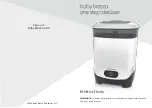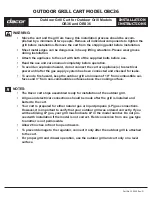
Order No. 2104 ..
i
It has to be considered that a shift of the displayed setpoint temperature (temperature
offset of the basic temperature) will directly affect the basic setpoint and as a result shift all
other temperature setpoints.
A positive shift is possible up to the configured heat protection temperature. A negative
shift is possible up to the set frost protection temperature.
i
The "Basic setpoint" object is not bidirectional, meaning that a shifted basic setpoint is not
signalled back to the KNX.
Whether a basic setpoint shifting only affects the currently active operating mode or whether it
influences all other set-temperatures of the remaining operating modes is determined by the
"Permanently apply change to basic setpoint shift" parameter in the "Room temperature control
-> Controller general -> Setpoints" parameter page...
-
"No" setting:
The basic setpoint shifting carried out is in effect for only as long as the operating mode or
heating/cooling mode has not changed or the basic setpoint is maintained. Otherwise the
setpoint shift will be reset to "0".
-
Setting "yes":
In general, the shifting of the basic setpoint carried out affects all operating modes. The
shift is maintained even after a switchover of the operating mode or the heating/cooling
mode or adjusting the basic setpoint.
i
Since the value for the basic setpoint shift is stored exclusively in volatile memory (RAM),
the shift will get lost in case of a reset (e.g. bus voltage failure).
i
A setpoint shift does not affect the temperature setpoints for frost or heat protection!
Communication objects for the basic setpoint shift:
The setpoint shift of the controller can be adjusted externally by the communication object
"Setpoint shift specification" with a 1-byte counter value (in compliance with KNX DPT 6.010 –
Depiction of positive and negative values in a double complement. By connecting to the
"Setpoint shift specification" object the controller extensions are able to directly adjust the
current setpoint shift of the controller. As soon as the controller receives a value, it will adjust
the setpoint shift correspondingly. Values that lie within the possible value range of the basic
setpoint shift can be directly jumped to.
The controller monitors the received value independently. As soon as the external preset value
exceeds the limits of the adjustment options for the setpoint shift in positive or negative
direction, the controller will correct the received value and adjust the setpoint shift to maximum.
Depending on the direction of the shift, the value feedback is set to the maximum value via the
communication object "Current setpoint shift".
The current setpoint shift is tracked by the controller in the communication object "Current
setpoint shift". This object has the same data point type and value range as the object "Setpoint
shift specification" (see above). By connecting to this object the controller extensions are also
able to display the current setpoint shift. As soon as there is an adjustment by one temperature
increment in positive direction, the controller counts up the value. The counter value will be
counted down if there is a negative adjustment of the temperature. A value of "0" means that no
setpoint shifting has been adjusted.
Example:
Initial situation: Current setpoint temperature = 21.0 °C / value of the setpoint shift = 0.5 K / /
Page 97 of 171
Software "KNX CO2 sensor"
Functional description
















































